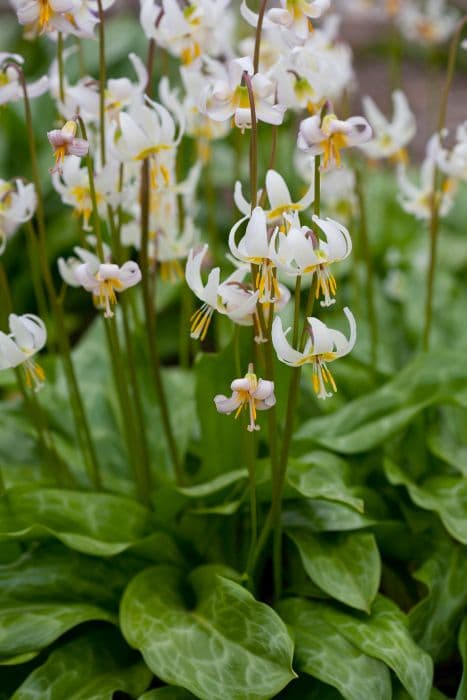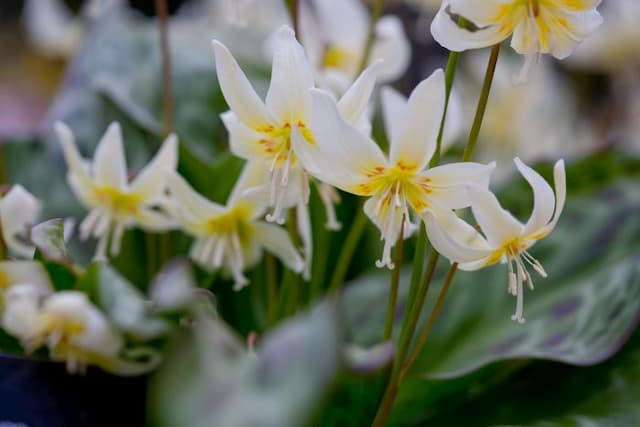Asiatic Lily Lilium 'Popstar' (Ia/c)

ABOUT
The Lilium 'Popstar' is a variety of lily that exhibits a striking appearance. It is characterized by its star-shaped flowers that bloom with a blend of colors. The petals typically exhibit a gradient of hues, often starting from a rich, warm base color that transitions to a lighter, softer edge. The flowers might have spots or brush strokes of contrasting colors, adding to their exotic and eye-catching look. The petals themselves are long, recurved, and may slightly curl back towards the stem, creating an elegant silhouette. Inside the bloom, one would notice prominent anthers that stand out and add to the visual interest of the flower. The pollen from these anthers may be a bold, contrasting color, which can be easily seen against the petals. The lily's foliage consists of lance-shaped leaves that are arranged spirally up the stem, providing a lush green backdrop to the vibrant flowers. The leaves are generally glossy and might have a fine texture that is pleasing to the touch. In bloom, the plant presents a bouquet of these stunning flowers, which can be a mix of fully opened blooms and ones that are just starting to unfurl. The 'Popstar' lily emanates a delightful fragrance that can permeate a garden space, inviting passersby to stop and enjoy the scents. This flower is a popular choice for gardens, borders, and as cut flowers in floral arrangements due to its arresting beauty and aroma.
About this plant
 Names
NamesFamily
Liliaceae
Synonyms
LA Hybrid Lily, Asiatic Lily, Oriental Lily
Common names
Lilium 'Popstar' (Ia/c)
 Toxicity
ToxicityTo humans
Lilies are known for their beauty, but they can pose a threat if ingested. The Lilium 'Popstar', or simply lily, contains compounds that are toxic to humans. Ingesting parts of the plant can cause symptoms such as nausea, vomiting, diarrhea, and abdominal pain. Additionally, eating significant amounts may lead to more severe consequences such as dehydration, electrolyte imbalances, and in extreme cases, potentially life-threatening conditions. It is crucial to keep lilies out of reach from children and to handle them with care to prevent accidental ingestion.
To pets
Lilies are highly toxic to cats. Ingesting even small amounts of any part of a lily plant can lead to acute kidney failure and can be fatal if not treated promptly. Symptoms of lily poisoning in pets, particularly cats, include vomiting, inappetence, lethargy, kidney failure, and sometimes even death. Dogs appear to be less affected by lily toxicity, but can still experience mild gastrointestinal discomfort if they consume the plant. Cats should never be allowed access to any part of a lily plant, and swift veterinary attention is required if a cat is suspected to have ingested any amount of lily.
 Characteristics
CharacteristicsLife cycle
Perennials
Foliage type
Deciduous
Color of leaves
Green
Flower color
Mixed
Height
2-3 feet (60-90 cm)
Spread
1 foot (30 cm)
Plant type
Bulb
Hardiness zones
4-9
Native area
Asia
Benefits
 General Benefits
General Benefits- Attractive Blooms: The plant features stunning flowers that can enhance the visual appeal of gardens and landscapes.
- Variety of Colors: Comes in a variety of colors, adding vibrancy and diversity to garden settings.
- Easy to Grow: Known for being relatively easy to cultivate, suitable for gardeners of varying skill levels.
- Perennial Growth: As a perennial, it returns year after year, reducing the need for annual replanting.
- Pollinator Friendly: Attracts bees, butterflies, and other pollinators, supporting local ecosystems.
- Cut Flower Use: Blooms are ideal for cutting and using in floral arrangements and bouquets.
- Seasonal Interest: Offers seasonal interest with its blooming cycle, often in the spring or summer.
- Compact Size: The 'Popstar' variety is often more compact, making it suitable for smaller gardens or containers.
 Medical Properties
Medical PropertiesThis plant is not used for medical purposes.
 Air-purifying Qualities
Air-purifying QualitiesThis plant is not specifically known for air purifying qualities.
 Other Uses
Other Uses- Lily 'Popstar' petals are edible and can be used to add a colorful garnish to salads or desserts, providing an exotic look and a subtly sweet flavor.
- The sturdy stems of the Lily 'Popstar' can be used in artisanal crafts for making natural wreaths and floral displays, adding a touch of elegance and color.
- The strong fragrance of Lily 'Popstar' makes it ideal for natural potpourri mixes or homemade scented sachets to freshen up drawers and closets.
- Floral artists can use dried Lily 'Popstar' blooms to create intricate pressed flower art, taking advantage of their striking color and form.
- Lily 'Popstar' can be a natural dye source for fabrics, yielding hues of pink or orange, depending on the mordant used in the dyeing process.
- The bloom can serve as a muse for photographers and painters, inspiring artwork with its stunning appearance and vivid colors.
- This plant's leaves and stems can be incorporated into a green roof garden design, contributing to urban biodiversity and providing habitat for insects.
- When planted strategically, Lily 'Popstar' can serve as a natural pest deterrent in the garden due to its strong scent, which some pests find repellent.
- The flowers of Lily 'Popstar' can be used in the creation of handmade floral water or natural room sprays, capturing their fragrance for personal care or home freshening.
- Lily 'Popstar' petals can be included in handcrafted paper, adding texture and flecks of color to the artisanal stationary or greeting cards.
Interesting Facts
 Feng Shui
Feng ShuiThe Lily, which is the common name for Lilium 'Popstar', is often associated with purity and peace in Feng Shui. It can be used to bring a sense of tranquility into the home and to promote a flow of positive energy, particularly when placed in areas like the bedroom or living room. Its blossoms are also believed to enhance love and harmony when displayed in the relationship area of a space.
 Zodiac Sign Compitability
Zodiac Sign CompitabilityThe Lily is not used in astrology practice.
 Plant Symbolism
Plant Symbolism- Purity - The lily is often associated with purity, especially the white lily. This stems from many cultural and religious contexts where lilies are seen as a symbol of innocence and chastity.
- Beauty - The striking appearance of lilies, including the 'Popstar' variety, symbolizes beauty and elegance, often admired in various cultures for their colorful and appealing blooms.
- Renewal and Rebirth - The lily can represent renewal and rebirth as it is a perennial plant that returns each year with fresh blooms, reflecting the cycle of life, creation, and new beginnings.
- Motherhood - In some traditions, lilies are symbolic of motherhood and fertility, representing the nurturing aspects of life and creation.
- Transition - The lily is sometimes used to symbolize transitions in life, including spiritual development or changes in personal circumstances.
- Passion - Although lilies are commonly connected to purity, they can also signify passion, especially the ones with deep or vibrant colors like the 'Popstar' lily.
- Weddings - Lilies, including the 'Popstar,' are often chosen for wedding bouquets and decorations as they embody purity, love, and unity, which are central themes to many marriage ceremonies.
 Water
WaterAsiatic lilies, like the 'Popstar', prefer consistently moist but well-drained soil. Water the plant thoroughly when the top inch of soil feels dry, which typically means you should water once a week. Adjust your watering schedule according to the weather; they may need more frequent watering during particularly hot or dry spells. It's important to avoid overhead watering to prevent fungal diseases. Ensure each watering session provides enough moisture to soak the roots, which could mean using approximately half a gallon per plant each time, depending on the size and the environmental conditions.
 Light
LightAsiatic lilies like 'Popstar' thrive best in full sun to partial shade conditions. The ideal spot is one where they can receive at least 6 to 8 hours of direct sunlight per day. Avoid excessively shaded areas as this can lead to weak growth and fewer blooms.
 Temperature
TemperatureThe 'Popstar' lily performs best in temperatures between 60°F and 70°F, which are ideal for their growth and flowering. They can survive a range within 40°F to 85°F but may not thrive if the temperature goes beyond these limits. It's important to protect them from extreme heat and frost.
 Pruning
PruningPrune 'Popstar' lilies to remove spent flowers and maintain plant health; this encourages further blooming. Deadheading the faded blooms can prevent seed formation, which drains energy from the plant. After flowering ceases, leave the stalks until they yellow in the fall as they help provide energy for the next season's growth. Pruning is best done with clean, sharp tools to prevent disease transmission.
 Cleaning
CleaningAs needed
 Soil
SoilAsiatic lily 'Popstar' thrives in well-drained soil rich in organic matter with a pH of 6.0 to 6.5. A mixture of loam, peat moss, and perlite or sand is ideal to provide the necessary drainage and aeration. Regularly adding compost will also benefit the soil's structure and fertility.
 Repotting
RepottingAsiatic lily 'Popstar' typically doesn't require frequent repotting and can be repotted every 2-3 years or when the bulbs outgrow their current container. Repotting is best done after the blooming period or in the fall.
 Humidity & Misting
Humidity & MistingAsiatic lily 'Popstar' prefers moderate humidity levels. While they do not require the high humidity levels some plants do, ensuring that the air around them is not too dry can benefit their growth and bloom.
 Suitable locations
Suitable locationsIndoor
Ensure bright, indirect light and good air circulation.
Outdoor
Choose a sunny spot with well-draining soil.
Hardiness zone
4-9 USDA
 Life cycle
Life cycleLilium 'Popstar', commonly known as the LA Hybrid Lily 'Popstar', begins its growth from a bulb, which after a period of dormancy, sends up shoots in the spring. The shoots develop into stems with leaves, and eventually, flower buds form. The buds bloom into vibrant flowers, which are typically large and colorful, marking the reproductive stage. After pollination, which may be carried out by insects, the flowers produce seed pods if conditions are favorable. Once the seeds mature, they are dispersed, and those that land in suitable conditions may germinate to produce new bulbs, continuing the cycle. During winter or unfavorable conditions, the plant goes back into dormancy, with the bulb surviving underground until the next growing season.
 Propogation
PropogationPropogation time
Early spring
Lilium 'Popstar', commonly known as an Asiatic lily, can be propagated most effectively through the division of its bulbs, a process best performed in the late fall after the foliage has withered, or in early spring before growth resumes. When dividing, carefully lift the bulbs from the soil, using a hand trowel or shovel. Gently separate the smaller bulblets from the main bulb, ensuring that each section has at least one scale with a bud. Replant these bulblets at a depth approximately three times the height of the bulb, about 4-6 inches (10-15 centimeters) for mature bulbs, in well-drained soil with ample organic matter. Space them about 12 inches (30 centimeters) apart to allow for adequate growth and air circulation. Water immediately after planting to help establish the bulblets. This method of propagation enables the lily to continue thriving and can result in a fuller bloom in the subsequent seasons.








